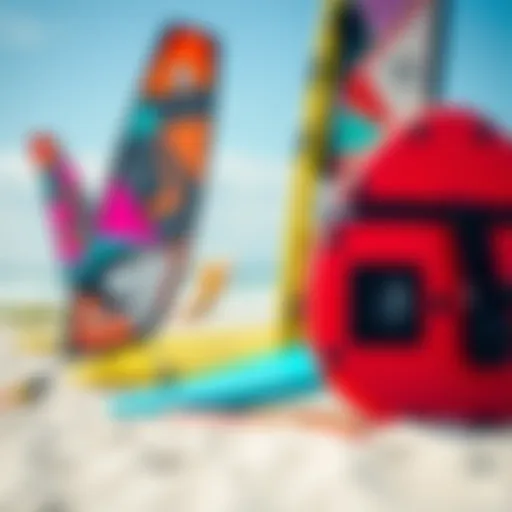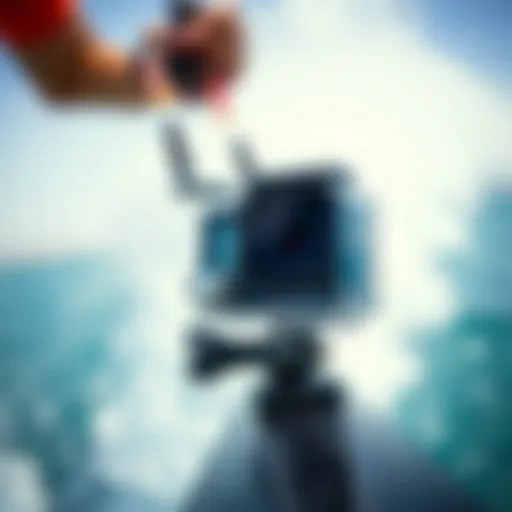Wetsuit Mittens: Key Gear for Kiteboarding Success
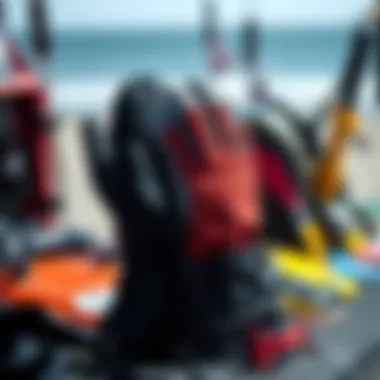
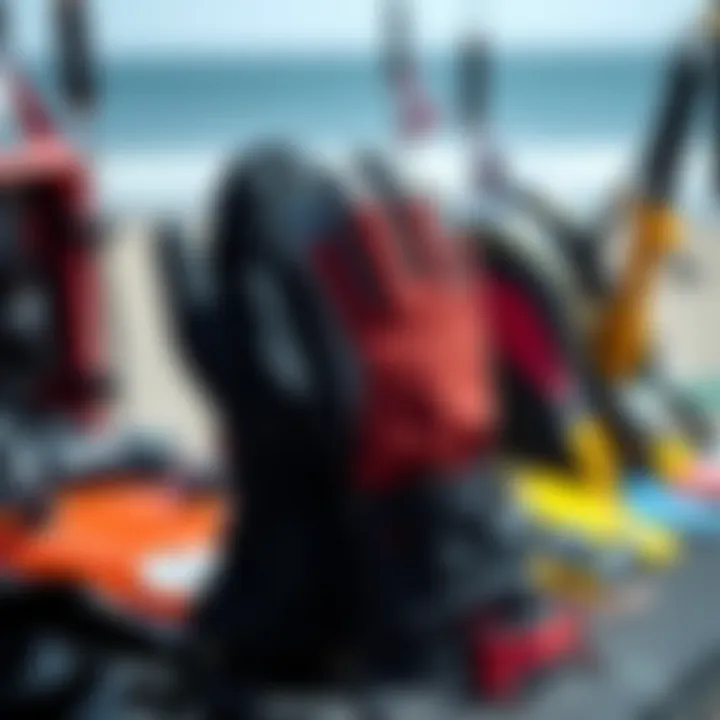
Intro
Kiteboarding is an exhilarating sport, combining the thrill of surfing with the freedom of flying. Yet, as any seasoned rider will tell you, the elements are both friend and foe. While the wind lifts you into the air, the chill of the water can quickly sap your strength and focus. Enter wetsuit mittens — a not-so-obvious hero in the kiteboarding arsenal.
In this exploration, we delve into the critical role of these mittens. Are they merely a luxury or a necessity? More importantly, how do they contribute to improved performance and comfort when out on the waves? With a variety of designs, materials, and features available, knowing what to look for can make the difference between an enjoyable session and a miserable one.
Understanding the nuances of wetsuit mittens can also empower kiteboarders — newbies and veterans alike — to make informed decisions regarding their gear. This discussion isn't just about keeping your hands warm; it’s about ensuring that your kiteboarding experience is nothing short of fantastic, regardless of conditions.
Let’s dive headfirst into the crucial insights on gear that can elevate your time on the water and keep you shredding, even when nature throws its quirks your way.
Understanding Wetsuit Mittens
Understanding wetsuit mittens is crucial for anyone serious about kiteboarding. Kiteboarding can often be a chilly endeavor, depending on the season and location. The dexterity and insulation these mittens offer can turn a mediocre session into a remarkable one. They are not just an accessory; they play a pivotal role in maintaining body warmth and providing grip on the equipment, ensuring an enjoyable and safer experience on the water.
Definition and Purpose
Wetsuit mittens are specialized gloves designed for water sports, particularly in cold conditions. These mittens are made from materials like neoprene, which offer insulating properties, keeping your hands warm and functional while engaging in a sport that demands both strength and finesse.
Their design is often bulkier than traditional gloves, providing a degree of insulation and allowing for increased thermal retention. The primary purpose of wetsuit mittens is to shield your hands from cold water, which can otherwise lead to numbness and loss of grip. In kiteboarding, where precision and control are paramount, having warm and agile hands directly influences performance.
Importance in Water Sports
The importance of wetsuit mittens in water sports cannot be overstated. They serve several key purposes:
- Warmth: Keeping your hands warm allows for longer sessions on the water, avoiding the discomfort that comes with cold extremities.
- Grip: A firm grasp on the kite's bar is essential; mittens with appropriate textures help enhance that grip, reducing the likelihood of accidental slips.
- Protection: These mittens act as a barrier between your hands and the harsh elements, such as sharp edges of equipment or cold water, lowering the risk of injuries.
In terms of performance, having appropriate mittens not only reduces fatigue but also enhances the overall kiteboarding experience. When your hands are warm and mobile, you’re less distracted by the chill and can focus on mastering techniques, navigating wind and waves with more agility.
"Wetsuit mittens are a game changer, transforming your kiteboarding experience in colder conditions."
For those who frequent cold-water locations, neglecting the need for these essential accessories could mean unwelcome distractions that hinder performance. The right wetsuit mittens don't just keep you warm; they become an integral part of how you interact with your gear and the environment.
With the above points in mind, investing in quality wetsuit mittens is no longer just advisable but essential for dedicated kiteboarders. This investment will offer not only comfort but practical benefits that enhance one's capability on the water.
Material Composition
The composition of materials used in wetsuit mittens plays a crucial role in their effectiveness and performance. For kiteboarders, understanding these materials is not just an asset; it's almost a matter of necessity. It's like knowing the engine of a car if you want it to run smoothly. From chilly waters to demanding maneuvers, the choice of materials can significantly impact comfort, insulation, and overall experience on the water.
Common Materials Used
Neoprene
Neoprene stands at the forefront as the most popular material for wetsuit mittens, and for good reason. It's not just about being flexible and durable; it's a true champion of thermal insulation. The key characteristic of neoprene is its ability to trap a thin layer of water next to the skin, which then warms up to provide that much-needed heat.
One unique feature of neoprene is its buoyancy; it allows for easy movement while maintaining warmth. However, there's a trade-off. Depending on thickness, neoprene can sometimes restrict dexterity. Despite this, its adaptability and longevity make it a solid choice for any kiteboarding enthusiast.
Thermal Linings
When temperatures drop, thermal linings come into play. These linings are designed to enhance the warmth of the mittens, retaining heat even in the most frigid conditions. The key characteristic here is how these linings trap warmth while remaining lightweight.
A unique aspect of thermal linings is that they often incorporate a soft, comfortable fabric that feels good against the skin, thus enhancing the overall user experience. Yet, it’s essential to note that while thermal linings add warmth, they can sometimes lead to a bulkier feel, which may impact the user's sense of touch when gripping equipment.
Seam Sealing Techniques
Seam sealing techniques hold an equally important role in the performance of wetsuit mittens. The integrity of seams is often the difference between a dry and wet experience. The primary characteristic of advanced seam sealing methods, such as blind stitching and taping, is their ability to prevent water from seeping through, which is vital during kiteboarding.
These techniques create a robust barrier against water ingress, thereby enhancing the overall functionality of the mittens. However, one must also consider the potential downsides; while well-sealed seams might provide greater waterproofing, they can sometimes be a little less flexible compared to traditionally stitched seams, affecting movement.
Material Durability
Abrasion Resistance
Durability is another cornerstone when it comes to choosing wetsuit mittens. Abrasion resistance is critical, especially given the rugged conditions often faced during kiteboarding. The unique feature of abrasion-resistant materials is their ability to withstand wear and tear, keeping the mittens intact over time.
A key characteristic of materials with high abrasion resistance is that they can endure rough surfaces—think of sand, rocks, and the inevitable encounters with the board. However, the downside can sometimes be the compromise on the overall soft feel of the mittens.
Longevity Under Stress
Lastly, it's essential to consider the longevity of materials under stress. This characteristic signifies how well the mittens maintain their integrity during intense activity. Wetsuit mittens need to be tough yet flexible enough to allow for a full range of motion. The unique aspect of well-constructed mittens is their balance between yielding to movement and resisting damage.
However, if the materials are too rigid, they risk wearing out faster and leading to potential discomfort for the wearer. Therefore, finding a middle ground is crucial for both performance and durability.


Design Considerations
When it comes to wetsuit mittens, design truly matters. The way mittens are cut, fitted, and crafted directly impacts the rider's experience on the water. Let's delve into these crucial design aspects that are not just for aesthetics but play vital roles in performance and comfort.
Cut and Fit
Different Styles of Wetsuit Mittens
The diversity in styles of wetsuit mittens stands out prominently. Whether one prefers a glove that mimics the dexterity of bare hands or a full mitt that gives the utmost warmth, knowing these options is key.
A common choice among kiteboarders is the five-finger mitt, which offers a balance of grip and warmth. These mittens allow for nuanced movements, enabling better control over the harness and kite. On the other side, lobster mitts, which separate the thumb and forefinger from the rest, provide better thermal insulation while still allowing for some level of finger movement. The main advantage? Riders can keep their hands warm without compromising too much on agility. The full mitt style is the warmest of the bunch, perfect for those frigid sessions. However, they can make precision tasks a bit tough.
Choosing the right style can lead to improved performance. If cold fingers lead to hesitation in maneuvers, selecting mitts that blend warmth with function can do wonders for confidence on the water.
Choosing the Right Fit
Nailing the fit of wetsuit mittens is just as vital as selecting the right style. A well-fitting mitten should feel snug yet allow for movement without constriction. If they’re too tight, circulation can be cut, leading to cold fingers. If too loose, they can flap around and impair grip.
Most brands offer sizing charts, but trying on a few pairs is highly recommended. The seal around the wrist is a unique feature; it prevents water from entering while also ensuring warmth is retained. A snug fit around the wrist is particularly beneficial when facing choppy waters. Riders should prioritize finding mittens that mold to their hands nicely without being overly restrictive, striking that delicate balance of comfort and functionality.
Grip and Dexterity
Palm Textures
The tactile sensation that gloves can provide is surprisingly critical in kiteboarding. Palm textures can make or break the experience. Some mittens come with a rubberized grip pattern that enhances handling on the boom and harness, making it easier to maneuver under various water conditions. The added texture facilitates that crucial connection between the rider and their gear.
A key characteristic of these palm textures is the ability to grip in wet conditions, preventing slips that could lead to accidents. For the rider, a confident grip translates to improved safety and performance, especially when the wind is howling. However, overly aggressive textures might make it difficult to slip fingers into or out of the mittens quickly.
Finger Isolation in Design
Finger isolation can be a game-changer. Some mittens feature compartments that allow fingers to move independently while still benefiting from the designs of mittens. Thumb mobility is essential for gripping the kite lines accurately. This can be a significant advantage during intricate maneuvers or when needing to harness a bit of speed during a session.
The main benefit of finger isolation is the enhanced control and sensitivity. Riders feel more connected to the bar or harness when the fingers aren’t jammed together. However, such designs may come with a cost; they might not offer as much insulation compared to fully enclosed options. Riders should weigh their priorities of warmth against the need for mobility, depending on the conditions they'll be facing.
Choosing mittens isn't merely a style decision; it's an investment in your performance and comfort in challenging conditions.
For those in search of resources or more information, consider checking out articles on Kiteboarding.com or community discussions on forums like Reddit for firsthand experiences from other kiteboarders.
Functionality and Performance
In the realm of kiteboarding, wetsuit mittens play an essential role that goes beyond mere comfort. Their primary functionalities—thermal insulation and water resistance—not only affect how long riders can stay on the water but also their overall performance and safety during sessions. An awareness of these factors is crucial for anyone spending hours in the brisk sea. The performance of a kiteboarder can be heavily influenced by how well their gear supports them through challenging conditions.
Thermal Insulation
Keeping Extremities Warm
One of the standout features of wetsuit mittens is their ability to keep your hands warm. Cold fingers can lead to decreased dexterity, making it tough to grip your board and control the kite effectively. No one wants to fumble around when the wind is up. With better thermal insulation, your extremities remain warm, ensuring that you can execute precise movements without feeling like you've got monkey paws for hands. While materials like neoprene are common, mittens with thicker linings or strategically placed insulation in high-impact areas offer unparalleled warmth.
Notably, how well your mittens achieve warmth can vary. Some mittens may prioritize flexibility over insulation, posing a potential disadvantage in particularly frigid waters. It’s essential to balance warmth with the ability to feel your gear in hand—too much warmth can come at the cost of sensitivity.
Impact on Riding Duration
The link between thermal insulation and riding duration is undeniable. The longer you stay warm, the more time you can spend enjoying the waves and the kites. A well-insulated pair of mittens allows riders to extend their sessions significantly. This means you can chase the perfect wave, enjoy the adrenaline rush, or simply take in the scenery without the annoying distraction of frozen fingers.
However, there’s a caveat with extended use: gloves that insulate too well can overheat the hands, causing discomfort. Finding the right balance is key in selecting mittens that cater to both cold conditions and long rides.
Water Resistance
Preventing Water Ingress
Water resistance in wetsuit mittens is just as vital as thermal insulation. It prevents cold water from rushing in and disrupting the warmth that your hands have carefully retained. Features like double cuffs or sealed seams are essential in creating barriers against water ingress. The better these elements work, the more time you can spend focused on your performance rather than worrying about chilly surprises.
Choosing a pair of mittens that excels in water resistance means you can trust that they will keep your hands dry during a fall or when splashes occur. However, mittens too well sealed can compromise breathability, which might cause sweaty palms. Striking the right balance here will only enhance your kiteboarding experience.
Seam Construction Effectiveness
The effectiveness of seam construction plays a critical role in maintaining the overall durability and water resistance of wetsuit mittens. Well-constructed seams can extend the life of your gear and ensure that it performs at its best even after several sessions.
The unique feature here is the type of seams used—flatlock seams, blind-stitched seams, and sealed seams each offer distinct advantages. For example, blind-stitched seams tend to be less prone to leaking, while flatlock seams may offer more flexibility for movement but can allow water to enter under specific conditions.
In summary, the design and effectiveness of the seam construction can greatly enhance or diminish how well the mittens function in water, making them a crucial consideration when selecting the right pair.
Choosing the Right Wetsuit Mittens
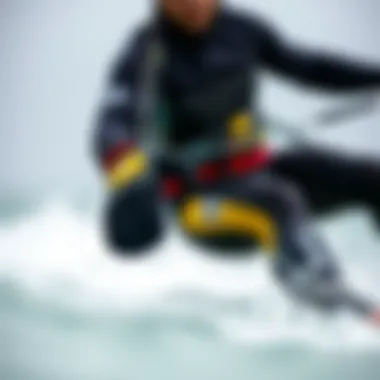
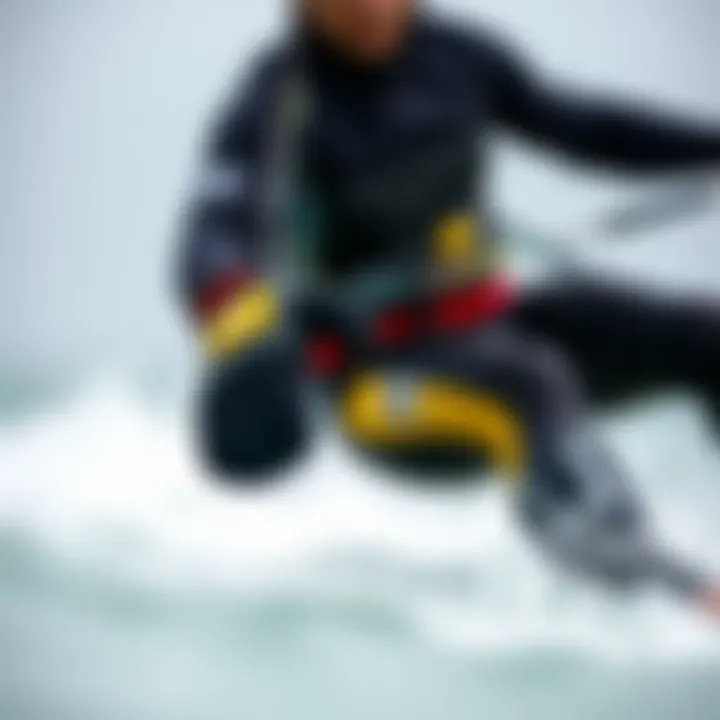
Choosing the right wetsuit mittens can mean the difference between a smooth ride and an uncomfortable session on the water. The sea can be unforgiving, and adequate protection for your hands is crucial, particularly when maneuvering a kite through windy conditions. In this section, we will delve into various elements that should influence your decision, including individual needs, brand comparisons, and price considerations.
Assessing Individual Needs
Temperature and Weather Conditions
When it comes to temperature and weather conditions, it's often said, "there's no such thing as bad weather, only inappropriate gear." In kiteboarding, understanding the climate is a key aspect to maximize your comfort and safety. The waters can be chillier than you might expect, especially in spring or autumn, when wind chill can drop temperatures even further.
Selecting mittens designed for different temperatures not only enhances coziness but also improves your grip on the lines. For instance, thicker, insulated mittens are ideal for colder climates while thinner, more flexible designs might work best in milder conditions. This distinction can significantly impact your performance, allowing you to focus solely on your riding.
The unique feature of temperature consideration lies in its ability to dictate your riding experience. If it's too cold and your hands are too numb, your responsiveness on the lines diminishes, leading to potential mishaps. Therefore, selecting mittens tailored to specific weather will largely benefit kiteboarders.
Personal Comfort Preferences
Now, let's talk about personal comfort preferences. A snug fit is essential, but comfort can be quite subjective. Some kiteboarders love the feel of thick insulation while others opt for minimalistic designs that allow for greater dexterity. Finding a balance is paramount.
The key characteristic here is usability during kiteboarding. Comfort often translates to confidence on the water; if your hands can move freely and are kept warm without feeling restrained, you're far likelier to make those precise adjustments that directly contribute to a successful ride. A mitt's tactile feedback can also enhance your ability to sense the kite's movements.
However, keep in mind that choosing overly tight mittens may lead to restricted blood flow, worsening cold sensitivity. Thus, testing for comfort should be prioritized before making a decision.
Brand Comparisons
Popular Brands in the Market
When considering popular brands, several names stand out in the wetsuit mitten scene. Brands like Rip Curl, O'Neill, and Mystic have been embraced by the kiteboarding community for their reliable and durable gear.
The brand's characteristics often lie in their reputation for quality and innovation in materials. For instance, O'Neill's focus on maximizing warmth with flexibility makes it a favorite among riders. When you invest in mittens from a recognized brand, you're not just paying for a name but also gaining access to their years of experience and expertise.
Unique features such as internal thermal linings or advanced seam sealing methods distinguish these brands in the market. However, newcomers might be tempted by lesser-known brands that offer lower prices but could lack the same level of quality and performance.
Price Point Analysis
Price point analysis plays a critical role in the decision-making process as well. Wetsuit mittens are available across a spectrum, with some options costing a pretty penny while others are easy on the wallet. While you might feel enticed to go for the cheaper option initially, consider the longevity and performance benefits of higher-priced mittens.
A critical point is that more expensive mittens usually incorporate superior materials or technology, leading to better insulation and durability. That said, the best value doesn’t always come from the individual with the highest price tag; it often comes down to features and how they align with what you value in your gear.
In summary, balancing your needs against your budget while considering brand reputation will lead to a more informed choice. Doing thorough research ensures that your experience on the water remains positive and memorable.
Maintenance of Wetsuit Mittens
Taking care of wetsuit mittens is crucial for their longevity and performance. These accessories endure harsh conditions and frequent wetting and drying, so proper maintenance becomes essential. Neglecting to maintain them can lead to deterioration, which ultimately affects how well they protect you during kiteboarding. Well-maintained mittens help ensure comfort, safety, and performance while riding the waves.
Cleaning Techniques
Proper Rinsing Methods
Proper rinsing methods play a pivotal role in how long your wetsuit mittens will last. After a day out in the water, it’s important to rinse them thoroughly in freshwater. Saltwater, chlorinated pools, and even sand can cause wear over time. Simply filling a large bucket with cool, clean water and allowing your mittens to soak for a few minutes can effectively remove any contaminants.
Using a gentle motion to rub the mittens together with your fingers helps dislodge stubborn particles. Avoid using harsh soaps as they can degrade the materials. The real beauty of proper rinsing lies in its simplicity—no fancy products needed, just a bit of care keeps those mittens spry and nimble.
Drying Practices
Once your mittens are rinsed, how you dry them is just as integral. Air drying is the golden standard. Turning the mittens inside out and hanging them in a shaded area is the way to go. This practice ensures that both the inside and outside dry properly, preventing mildew and unpleasant odors. The main drawback of drying them in direct sunlight is that UV rays can weaken the neoprene over time. Thus, patience is key. What might seem like a hassle turns out to be a simple step that preserves the quality.
Storage Recommendations
How to Prevent Damage
Storing wetsuit mittens correctly ensures they stay in top-notch condition when not in use. First, curling or crumpling mittens easily leads to deformities, so lay them flat or hang them if possible. Using a storage bag can help prevent any potential punctures or tears from other gear. Keeping them in a cool, dry place, away from direct sunlight is critical. It minimizes exposure to the elements that might otherwise cause degradation. The unique feature of preventing damage lies in the fact that a little foresight goes a long way in keeping these accessories in shape for your next kiteboarding adventure.
Best Environment for Storage
Creating an optimal storage environment for your wetsuit mittens can extend their lifespan significantly. Ideally, find a location that is neither too humid nor too dry, as extreme conditions often lead to cracking and loss of flexibility. A temperature-controlled space, like a closet, will do wonders for keeping the mittens intact. Some enthusiasts use a dedicated gear bag, which not only keeps mittens and other equipment organized but also shielded from external factors. This particular setup is advantageous—it allows you to access your gear swiftly before heading out, while protecting it from unnecessary wear when it’s not in use.
Taking the time to maintain your wetsuit mittens ensures you have a reliable accessory when you hit the waters, enhancing your overall kiteboarding experience.
Impact on Kiteboarding Experience
Wetsuit mittens serve more than just a fashion statement in the world of kiteboarding. They are integral for an optimal experience on the water. The impact of these mittens on kiteboarding goes beyond keeping hands warm. They are pivotal for enhancing overall performance, safety, and enjoyment. Understanding how these elements interplay equips kiteboarders, instructors, and adventurers alike with the knowledge to make informed choices.
Enhancing Performance
Impact on Maneuverability


Maneuverability is a crucial component when riding the waves and battling the winds while kiteboarding. Wetsuit mittens can play a significant role in this area. One of the most striking characteristics of mittens designed for this sport is their ability to allow for quick, yet robust, movements despite the cold water. A well-fitted mitten should hug the hand snugly, allowing for better control over the kite.
One unique feature of many modern mittens is the specific cut that permits finger isolation, meaning the dexterity is preserved while still providing warmth. This balance between warmth and mobility is essential since even a slight delay in responding to the kite can affect performance. Moreover, high-quality materials often used in these mittens provide an adequate grip on the bar, playing a key role in holding it steady against strong gusts – a major advantage for any kiteboarder looking to enhance control and precision during maneuvers.
Effect on Handling
Handling, or how one navigates and steers while kiteboarding, can be directly influenced by the choice of wetsuit mittens. A mitten that allows for superior grip can lead to significantly improved handling in various conditions. The key characteristic here is the palm texture. Textured palms give the rider confidence to feel their gear, control the kite more effectively, and make those crucial adjustments in navigation.
The technology behind mitten design often incorporates advanced materials that blend flexibility with durability. However, if a mitten is too bulky, it can hinder the tactile feedback between the rider and the equipment, resulting in a less dynamic experience on the water. Thus, striking a balance between insulation and responsiveness is essential and certainly something to consider when selecting the right mittens.
Safety Considerations
Avoiding Hypothermia
Staying warm is more than a comfort issue; it is a matter of safety in kiteboarding. Hypothermia is one risk that riders face, especially in colder waters. The characteristic that makes wetsuit mittens indispensable here is their thermal insulation. Most mittens trap heat effectively while still enabling some level of water escape, helping to maintain warmth without letting in too much chill.
This thermal barrier helps prolong sessions in the water, making it possible for riders to enjoy kiteboarding without constant interruption due to the cold. However, it is vital to ensure that mittens are well-fitted as loose-fitting gloves can allow water to seep in, defeating their purpose. So, when selecting mittens, it’s wise to consider how well they perform in colder conditions.
Protective Benefits Against Injuries
The protective capabilities of wetsuit mittens cannot be overlooked. While engaging in kiteboarding, a fall can lead to potential injuries on the hands – a common concern. These mittens provide an extra layer of defense against abrasions and cuts that might occur during wipeouts or when being near the board.
One notable feature of protective mittens is their reinforced seams and materials designed to resist punctures. This not only safeguards against the elements but also minimizes the risk of injury from sharp objects in the water, such as rocks or other debris. Incorporating mittens into your kiteboarding gear can thus enhance safety, keeping the focus on the ride rather than worrying about minor injuries.
Innovations and Future Trends
The kiteboarding industry is ever-evolving, just like the winds we ride. As technology advances and the focus on sustainability grows, wetsuit mittens are also getting a makeover. In this section, we will dive into the cutting-edge developments that shape the future of these essential accessories. The innovations serve not just to enhance performance but also to ensure that kiteboarders can enjoy their time on the water safely and sustainably.
Technological Advancements
New Materials
New materials are truly the heart of innovation in wetsuit mittens. Recent advancements in insulation and flexibility mean that kiteboarders can expect better thermal protection without sacrificing dexterity. For instance, materials like Yamamoto neoprene, derived from limestone, offer lightweight alternatives to traditional petroleum-based products. This choice is popular, as it is not only light but also provides enhanced stretchiness and warmth.
Moreover, new composite materials exhibit remarkable durability, allowing mittens to withstand wear and tear while remaining supple. Think of these as the Swiss Army knife of wetsuit mittens; they are resilient yet flexible, striking the right balance for kiteboarding enthusiasts who demand performance. However, it's worth noting that these newer materials can sometimes come at a steeper price point, which might discourage some buyers.
Smart Features in Gear
On the technology front, smart features in gear are pushing the limits of what wetsuit mittens can do. Some are now being equipped with thermoregulation features, which adapt to the body’s temperature, keeping hands warm when needed or preventing overheating. This capability translates to a more enjoyable and controlled experience on the water.
Notably, some mittens include buoyancy assistance. These designs help keep the mittens afloat, ensuring they do not become a lost item in the depths, which is a practical feature for those hitting the water frequently. While these innovations are fascinating, they can introduce a degree of complexity; not all riders feel comfortable with high-tech options or understand how to maintain them properly.
Sustainability in Production
Environmentally Friendly Materials
As kiteboarders become more eco-conscious, the demand for environmentally friendly materials has surged. Wetsuit mittens made from eco-friendly materials such as recycled plastics or plant-based substances are gaining traction. A notable characteristic of these materials is that they reduce environmental impact by minimizing waste and promoting resource conservation.
These environmentally sustainable options also reflect a growing corporate responsibility among manufacturers. They show that brands can be both profitable and committed to the environment. However, the downside may include material performance during high-stress conditions, which might not match traditional materials. It's a balancing act, but one that increasingly resonates with environmentally-aware consumers.
Eco-Friendly Manufacturing Practices
It's not just about what materials are used; how they are produced matters greatly too. Eco-friendly manufacturing practices, such as reducing water usage and minimizing carbon footprint during production, are becoming hallmarks of leading wetsuit brands. By employing techniques like low-impact dyes and energy-efficient processes, these brands set a benchmark for sustainability in the kiteboarding industry.
This shift can influence decisions at the point of sale. Traditional manufacturing techniques often overlook ecological responsibility, but as consumers demand better practices, brands adopting these methods may gain a competitive edge. Nonetheless, those premium features might lead to higher costs for the final product, which could be seen as a disadvantage for budget-conscious riders.
"The kiteboarding community is at the forefront of embracing innovation and sustainability, ensuring every adventure respects the natural playground we cherish."
In closing, it's clear that the future of wetsuit mittens is not just about surviving the water's chill. It's about thriving ahead of market trends through innovation and a sincere commitment to sustainability. For kiteboarders, these advancements mean a better experience on the waves, knowing they are making choices that benefit both their performance and the planet.
Epilogue
As we wrap up this exploration of wetsuit mittens, it’s clear that these seemingly simple accessories play a crucial role in the world of kiteboarding. They aren’t just an afterthought but an essential part of a kiteboarder's gear selection. The importance of selecting the right wetsuit mittens cannot be overstated, as their impact stretches from comfort to performance and safety in adverse weather conditions.
Summary of Key Points
- Thermal Insulation: Wetsuit mittens provide much-needed warmth, which directly influences ride duration and comfort. The cold can dampen even the most enthusiastic spirits, so insulated mittens keep hands warm and functional.
- Grip and Dexterity: The right mittens enhance grip on the board and control of the kite, enabling better performances. The design, including palm textures and finger isolation, ensures you can still feel what you're doing.
- Choice of Materials: Understanding the materials—like neoprene and thermal linings—will help kiteboarders select mittens that last longer and protect better against the elements.
- Maintenance: Proper care extends the lifespan of wetsuit mittens. Cleaning and storing them correctly ensures they perform at their best when it matters most.
- Innovative Trends: Awareness of new materials and eco-friendly practices helps inform purchasing decisions, aligning personal values with product choices.
In short, the right wetsuit mittens make a significant difference in the riding experience, particularly regarding comfort and safety. This guide highlights that with the right preparation and understanding of the advantages these mittens offer, kiteboarders can take full advantage of their time on the water.
Final Thoughts
To truly find the best wetsuit mittens for your kiteboarding adventures, consider your individual needs based on the weather conditions you frequently encounter. The market is flooded with options, and what works for one might not work for another. So dive into the specifics—check how mittens fit, evaluate their thermal properties, and assess how they enhance your grip on the gear.
Ultimately, investing in high-quality wetsuit mittens is a step toward enhancing your entire kiteboarding experience. Whether you’re an instructor imparting skills to newcomers or an adventurer chasing winds across open waters, the right gear can make all the difference. Don’t just check the box on your list of equipment; choose wisely and surf with confidence.
"The sea is a teacher and a companion, and every rider must have the right tools to embrace its lessons."
For those wanting more detailed information and community insights, resources like Reddit and educational sites like Britannica can provide additional perspectives.











